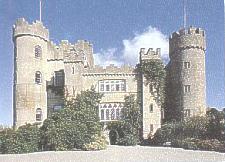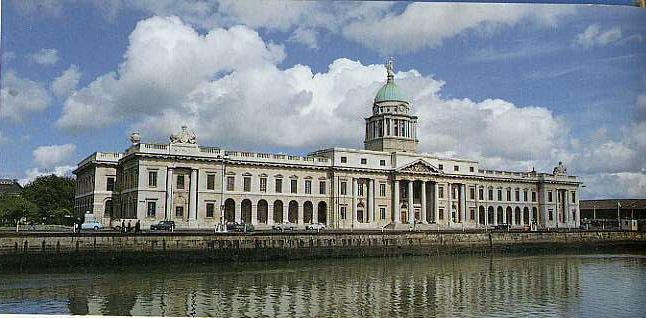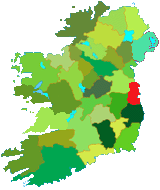| County
Dublin from Samuel Lewis' Topographical
Directory of Ireland 1837
The name Dublin comes from Dubh linn 'Black pool' The
original Celtic name is Baile Ätha Cliath 'town of the
hurdles' Dublin is said to have been
founded when the Vikings
first over wintered there in 840 although the swampy site
is said to have been inhabited from much earlier times by
the Blanii or Eblani.
from Dubh linn 'Black pool' The
original Celtic name is Baile Ätha Cliath 'town of the
hurdles' Dublin is said to have been
founded when the Vikings
first over wintered there in 840 although the swampy site
is said to have been inhabited from much earlier times by
the Blanii or Eblani.
By
the 10th century Dublin had grown to be the largest Viking
settlement in Ireland, it may have been used to export slaves
captured in Ireland to Scandinavia Control of Dublin remained
in Norse hands until 1014 when they were ousted by Brian
Boru, at the Battle of Clontarf, after that the Irish
held sway for little more than 150 years.
Tribal
infighting led ultimately to the country being invaded by
the Anglo Normans
in 1170. Dermot MacMurrough,
the deposed king of Leinster, in a naive attempt to regain
his kingship invited the Norman Earl of Pembroke, known as
Strongbow, to assist him. MacMurrough offered Strongbow his
daughter Aoife and succession to his kingship, the following
year MacMurrough died and Strongbow assumed the kingship of
Leinster.
This
 marked the beginning of a period
of Anglo Norman domination which was to last for about 750
years. Initially their control was confined to an area around
Dublin known as the pale, the rather fluid borders of which
are marked today with the ruins of military outposts, tower
houses, and fortified manors. marked the beginning of a period
of Anglo Norman domination which was to last for about 750
years. Initially their control was confined to an area around
Dublin known as the pale, the rather fluid borders of which
are marked today with the ruins of military outposts, tower
houses, and fortified manors.
In
the intervening centuries the town has grown into a modern
sprawling cosmopolitan city to rival any in Europe, in recent
years (2005) the city has experienced a period of phenomenal
growth fueled by the aptly named 'Celtic Tiger Economy' the
skyline is dominated by modern buildings and a forest of tower
cranes busily engaged in constructing more. Not that the tourist
is search of peace and tranquility should be dismayed,  you
just need travel about twenty kilometers from the center in
any direction (except east) and you will find serenity, seclusion
and some of the beautiful scenery which has made Ireland famous. you
just need travel about twenty kilometers from the center in
any direction (except east) and you will find serenity, seclusion
and some of the beautiful scenery which has made Ireland famous.
The county of Dublin is enclosed by
the counties of Meath and
Kildare to the west,
Wicklow to the south
and the Irish sea to the east. The county possesses an excellent
transport system with motorways radiating in all directions,
visiting motorists should note that some of these collect
tolls, so be sure to have a few euros to hand, and try to
avoid driving through the city during the morning and evening
rush hours.
There
is much to be seen in and around the city, the treasures of
Ireland's past are gathered in the museums,
and art galleries, tourist attractions abound, accommodation
from b & b to five
star luxury hotels can easily
be found.
Tourist Information
Dublin City
Co Dublin
Tel +353 (0)1850 230 330
E Mail
Web
Site |
Read about County
Dublin from Samuel Lewis' Topographical
Directory of Ireland puplished in 1837.
|
|



 you
just need travel about twenty kilometers from the center in
any direction (except east) and you will find serenity, seclusion
and some of the beautiful scenery which has made Ireland famous.
you
just need travel about twenty kilometers from the center in
any direction (except east) and you will find serenity, seclusion
and some of the beautiful scenery which has made Ireland famous.